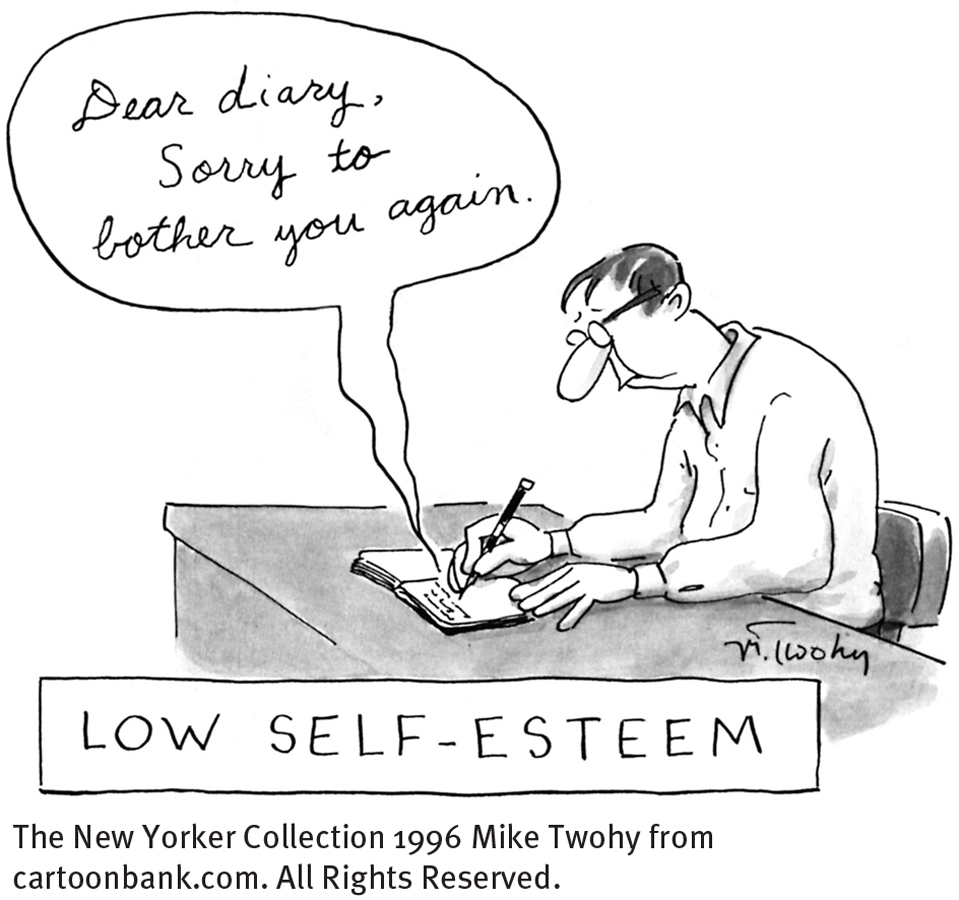7.1 Unipolar Depression: The Depressive Disorders
Whenever we feel particularly unhappy, we are likely to describe ourselves as “depressed.” In all likelihood, we are merely responding to sad events, fatigue, or unhappy thoughts. This loose use of the term confuses a perfectly normal mood swing with a clinical syndrome. All of us experience dejection from time to time, but only some experience a depressive disorder.
Normal dejection is seldom severe enough to influence daily functioning significantly or persist very long. Such downturns in mood can even be beneficial. Periods spent in contemplation can lead us to explore our inner selves, our values, and our way of life, and we often emerge with an increased sense of strength, clarity, and resolve.
Almost every day we have ups and downs in mood. How can we distinguish the everyday blues from clinical depression?
Depressive disorders, on the other hand, have no redeeming characteristics. They bring severe and long-
How Common Is Unipolar Depression?
|
Brazil |
10.4 |
|
Ukraine |
8.4 |
|
United States |
8.3 |
|
New Zealand |
6.6 |
|
Colombia |
6.2 |
|
Israel |
6.1 |
|
France |
5.9 |
|
Lebanon |
5.5 |
|
Belgium |
5.0 |
|
Netherlands |
4.9 |
|
South Africa |
4.9 |
|
Spain |
4.0 |
|
Mexico |
4.0 |
|
Italy |
3.0 |
|
Germany |
3.0 |
|
Japan |
2.2 |
|
Information from: Bromet et al., 2011 |
|
Around 9 percent of adults in the United States suffer from a severe unipolar pattern of depression in any given year, while as many as 5 percent suffer from mild forms (Kessler et al., 2012, 2010, 2005). Around 18 percent of all adults experience an episode of severe unipolar depression at some point in their lives. These prevalence rates are similar in Canada, England, France, and many other countries (see Table 7-1). Moreover, the rate of depression—
People of any age may suffer from unipolar depression. In most countries, however, people in their forties are more likely than those in any other age group to experience this problem (CDC, 2012). The median age for its onset, now 26 in the United States, keeps dropping for each generation, and worldwide research projects suggest that the risk of experiencing unipolar depression has increased steadily since 1915 (González et al., 2010; Weissman et al., 1992, 1991).
Women are at least twice as likely as men to have episodes of severe unipolar depression (WHO, 2014; Astbury, 2010). As many as 26 percent of women have an episode at some time in their lives, compared with 12 percent of men. As you will see in Chapter 17, among children the prevalence of unipolar depression is similar for girls and boys.
Approximately 85 percent of people with unipolar depression recover, some without treatment. At least 40 percent of them have at least one other episode of depression later in their lives (Monroe, 2010; Whisman & Schonbrun, 2010; Eaton et al., 2008).
What Are the Symptoms of Depression?
The picture of depression may vary from person to person. Earlier you saw how Meri’s profound sadness, fatigue, and cognitive deterioration brought her job and social life to a standstill. Some depressed people have symptoms that are less severe. They manage to function, although their depression typically robs them of much effectiveness or pleasure.
As the case of Meri indicates, depression has many symptoms other than sadness. The symptoms, which often exacerbate one another, span five areas of functioning: emotional, motivational, behavioral, cognitive, and physical.
Emotional SymptomsMost people who are depressed feel sad and dejected. They describe themselves as feeling “miserable,” “empty,” and “humiliated.” They tend to lose their sense of humor, report getting little pleasure from anything, and in some cases display anhedonia, an inability to experience any pleasure at all. A number also experience anxiety, anger, or agitation. This sea of misery may lead to crying spells (see MediaSpeak below). Terrie Williams, author of Black Pain, a book about depression in African Americans, describes the agony she went through each morning as her depression was unfolding:
Nights I could handle. I fell asleep easily, and sleep allowed me to forget. But my mornings were unmanageable. To wake up each morning was to remember once again that the world by which I defined myself was no more. Soon after opening my eyes, the crying bouts would start and I’d sit alone for hours, weeping and mourning my losses.
(Williams, 2008, p. 9)
Motivational SymptomsDepressed people typically lose the desire to pursue their usual activities. Almost all report a lack of drive, initiative, and spontaneity. They may have to force themselves to go to work, talk with friends, eat meals, or have sex. This state has been described as a “paralysis of will” (Beck, 1967). Terrie describes her social withdrawal during a depressive episode:
I woke up one morning with a knot of fear in my stomach so crippling that I couldn’t face light, much less day, and so intense that I stayed in bed for three days with the shades drawn and the lights out.
Three days. Three days not answering the phone. Three days not checking my e-
(Williams, 2008, p. xxiv)
MediaSpeak
The Crying Game: Male Versus Female Tears
By Jocelyn Noveck, The Associated Press
“Please, please, please, just give the dog back,” Ellen DeGeneres wept on national TV. … It was a moment that quickly established itself in the pop-
(To recap: DeGeneres had adopted Iggy from a rescue organization, then given it to her hairdresser’s family when the dog didn’t get along with her cats. That was against the rules, and the rescue group took the dog back. …)
Setting aside the question of whether those sobs were 100 percent genuine, tears are a natural human response, and public figures are obviously not immune. But some who study this most basic expression of feeling will tell you that in this day and age, it can be easier for a crying man to be taken seriously than a crying woman.
In politics, it’s a far cry … from 1972, when Sen. Ed Muskie’s presidential campaign was derailed by what were perceived to be tears in response to a newspaper attack on his wife. But decades later, an occasional Clintonesque tear is seen as a positive thing.
Bill Clinton, that is.
“Bill could cry, and did, but Hillary can’t,” says Tom Lutz, a professor at the University of California, Riverside, who authored an exhaustive history of crying. … [T]he same tearful response that would be seen as sensitivity in Bill could be seen as a lack of control in his wife.
But there are additional rules for acceptable public crying. “We’re talking about dropping a tear,” Lutz notes, “no more than a tear or two.” And it all depends on the perceived seriousness of the subject matter. Thus Jon Stewart or David Letterman could choke up with impunity just after 9/11. But a dog-

In a recently published study at Penn State, researchers sought to explore differing perceptions of crying in men and women, presenting their 284 subjects with a series of hypothetical vignettes. Reactions depended on the type of crying, and who was doing it. A moist eye was viewed much more positively than open crying, and males got the most positive responses.
“Women are not making it up when they say they’re damned if they do, damned if they don’t,” said Stephanie Shields, the psychology professor who conducted the study. “If you don’t express any emotion, you’re seen as not human, like Mr. Spock on ‘Star Trek,’” she said. “But too much crying, or the wrong kind, and you’re labeled as overemotional, out of control and possibly irrational.”
That comes as no surprise to Suzyn Waldman, a well-
… Her tearful report quickly became an Internet hit, and she was mocked far and wide, especially on radio. …
“When men express anger they gain status, but when women express anger they lose status,” [says] Yale social psychologist Victoria Brescoll. …
For a little historical perspective, says Lutz, author of “Crying: The Natural and Cultural History of Tears,” it’s helpful to look back to the 19th century, when skillful politicians like Abraham Lincoln used tears as a natural part of their oratory.
The tide later shifted against male crying, but in the past 30 to 40 years male crying has gained in acceptability. “Every president since Ronald Reagan has used tears at some point,” says Shields, the Penn State psychologist. … Military figures have cried at critical moments. Gen. Norman Schwarzkopf cried at a Christmas Eve ceremony in front of his troops, and when interviewed by Barbara Walters, Lutz notes.
… But in DeGeneres’ case, along with the strong support from fans and many dog lovers, she also endured some criticism and mockery. …
Jocelyn Noveck, “The Crying Game: Male vs. Female Tears,” The Associated Press, October 25, 2007. Used with permission of The Associated Press Copyright© 2014. All rights reserved.
Suicide represents the ultimate escape from life’s challenges. As you will see in Chapter 9, many depressed people become uninterested in life or wish to die; others wish they could kill themselves, and some actually do. It has been estimated that between 6 and 15 percent of people who suffer from severe depression commit suicide (MHF, 2014; Alridge, 2012; Mulholland, 2010).
Behavioral SymptomsDepressed people are usually less active and less productive. They spend more time alone and may stay in bed for long periods. One man recalls, “I’d awaken early, but I’d just lie there—
Cognitive SymptomsDepressed people hold extremely negative views of themselves. They consider themselves inadequate, undesirable, inferior, perhaps evil (Lopez Molina et al., 2014; Sowislo & Orth, 2012). They also blame themselves for nearly every unfortunate event, even things that have nothing to do with them, and they rarely credit themselves for positive achievements.
Another cognitive symptom of depression is pessimism. Sufferers are usually convinced that nothing will ever improve, and they feel helpless to change any aspect of their lives. Because they expect the worst, they are likely to procrastinate. Their sense of hopelessness and helplessness makes them especially vulnerable to suicidal thinking (Shiratori et al., 2014; Wilson & Deane, 2010).
People with depression frequently complain that their intellectual ability is poor. They feel confused, unable to remember things, easily distracted, and unable to solve even the smallest problems. In laboratory studies, depressed people do perform more poorly than nondepressed people on some tasks of memory, attention, and reasoning (Chen et al., 2013; Lyche et al., 2011). It may be, however, that these difficulties sometimes reflect motivational problems rather than cognitive ones.

Physical SymptomsPeople who are depressed frequently have such physical ailments as headaches, indigestion, constipation, dizzy spells, and general pain (Bai et al., 2014; Goldstein et al., 2011). In fact, many depressions are misdiagnosed as medical problems at first (Parker & Hyett, 2010). Disturbances in appetite and sleep are particularly common (Jackson et al., 2014; Armitage & Arnedt, 2011). Most depressed people eat less, sleep less, and feel more fatigued than they did prior to the disorder. Some, however, eat and sleep excessively. Terrie Williams describes the changes in the pattern of her sleep:
At first I didn’t notice the change. Then things got worse. I always hated waking up, but slowly it was turning into something deeper; it was less like I didn’t want to wake up, and more like I couldn’t. I didn’t feel tired, but I had no energy. I didn’t feel sleepy, but I would have welcomed sleep with open arms. I had the sensation of a huge weight, invisible but gigantic, pressing down on me, almost crushing me into the bed and pinning me there.
(Williams, 2008, p. xxii)
Diagnosing Unipolar Depression
|
Major Depressive Episode |
|
|
1. |
For a 2- |
|
2. |
For the same 2 weeks, person also experiences at least 3 or 4 of the following symptoms: • Considerable weight change or appetite change • Daily insomnia or hypersomnia • Daily agitation or decrease in motor activity • Daily fatigue or lethargy • Daily feelings of worthlessness or excessive guilt • Daily reduction in concentration or decisiveness • Repeated focus on death or suicide, a suicide plan, or a suicide attempt. |
|
3. |
Significant distress or impairment. |
|
Major Depressive Disorder |
|
|
1. |
Presence of a major depressive episode. |
|
2. |
No pattern of mania or hypomania. |
|
Persistent Depressive Disorder |
|
|
1. |
Person experiences the symptoms of major or mild depression for at least 2 years. |
|
2. |
During the 2- |
|
3. |
No history of mania or hypomania. |
|
4. |
Significant distress or impairment. |
|
Information from: APA, 2013. |
|
According to DSM-
DSM-
 major depressive disorder A severe pattern of depression that is disabling and is not caused by such factors as drugs or a general medical condition.
major depressive disorder A severe pattern of depression that is disabling and is not caused by such factors as drugs or a general medical condition.
People whose unipolar depression is chronic receive a diagnosis of persistent depressive disorder (APA, 2013) (see Table 7-2 again). Some people with this chronic disorder have repeated major depressive episodes, a pattern technically called persistent depressive disorder with major depressive episodes. Others have less severe and less disabling symptoms, a pattern technically called persistent depressive disorder with dysthymic syndrome.
 persistent depressive disorder A chronic form of unipolar depression marked by ongoing and repeated symptoms of either major or mild depression.
persistent depressive disorder A chronic form of unipolar depression marked by ongoing and repeated symptoms of either major or mild depression.
A third type of depressive disorder is premenstrual dysphoric disorder, a diagnosis given to certain women who repeatedly have clinically significant depressive and related symptoms during the week before menstruation. This inclusion of this pattern in DSM-
 premenstrual dysphoric disorder A disorder marked by repeated episodes of significant depression and related symptoms during the week before menstruation.
premenstrual dysphoric disorder A disorder marked by repeated episodes of significant depression and related symptoms during the week before menstruation.
PsychWatch
Sadness at the Happiest of Times
Women usually expect the birth of a child to be a happy experience. But for 10 to 30 percent of new mothers, the weeks and months after childbirth bring clinical depression (Guintivano et al., 2014; Kendall-

The “baby blues” are so common—
In postpartum depression, however, depressive symptoms continue and may last up to a year or more. The symptoms include extreme sadness, despair, tearfulness, insomnia, anxiety, intrusive thoughts, compulsions, panic attacks, feelings of inability to cope, and suicidal thoughts. The mother–
Many clinicians believe that the hormonal changes accompanying childbirth trigger postpartum depression. All women go through a kind of hormone “withdrawal” after delivery, as estrogen and progesterone levels, which rise as much as 50 times above normal during pregnancy, now drop sharply to levels far below normal (Horowitz et al., 2005, 1995). Perhaps some women are particularly influenced by these dramatic hormone changes (Mehta et al., 2014). Other theorists suggest that some women may have a genetic predisposition to postpartum depression (Guintivano et al., 2014; Comasco et al., 2011). A woman with a family history of mood disorders appears to be at high risk, even if she herself has not previously had a mood disorder (Phillips, 2011; APA, 2000).
At the same time, psychological and sociocultural factors may play important roles in the disorder (Mauthner, 2010). The birth of a baby brings enormous psychological and social change. A woman typically faces changes in her marital relationship, daily routines, and social roles. Sleep and relaxation are likely to decrease, and financial pressures may increase. Perhaps she feels the added stress of giving up a career—
Fortunately, treatment can make a big difference for most women with postpartum depression. Self-
However, many women who would benefit from treatment do not seek help because they feel ashamed about being sad at a time that is supposed to be joyous and are concerned about being judged harshly (Bina, 2014; Mauthner, 2010). For them, and for the spouses and family members close to them, a large dose of education is in order. Even positive events, such as the birth of a child, can be stressful if they also bring major change to one’s life. Recognizing and addressing such feelings are in everyone’s best interest.
BETWEEN THE LINES
World Count
More than 350 million people suffer from depression worldwide (World Health Organization, 2012).
Yet another kind of depressive disorder, disruptive mood dysregulation disorder, is characterized by a combination of persistent depressive symptoms and recurrent outbursts of severe temper. This disorder emerges during mid-